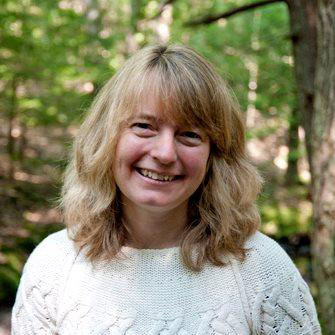Kristen Lindquist: Ducks in trees
On one of the first warm mornings of spring, as I sat out on my back porch watching the mighty Megunticook flow briskly past, a bird flew upriver and perched in a nearby tree. My brain vaguely registered a roundish brown bird—dove, perhaps, or thrush? But when I actually took a good look, I quickly realized it was bigger than that, and not a songbird at all, but a duck. A duck in a tree!
With binoculars, the small duck's white spectacles became apparent: female Wood Duck. She stood on the branch looking back downriver and vocalizing, a high-pitched squealing. Was she calling her mate? Yes, there he was, in another tree on the other side of the yard. A pair of Wood Ducks, in our yard!
A male Wood Duck looks like nothing else. He's one of the most distinctly patterned birds around, sporting a drooping, glossy green crest over a dark face patterned with white, accented by a bright red eye-ring and an orange-red bill. His body is color-blocked dark brown with black and white markings, buff flanks, an iridescent purple-green back, and a long, dark tail. When he flies, he reveals a white belly. Birder Pete Dunne describes him as "a 15th-Century galleon of a puddle duck, complete with ornate figurehead."
He's garish in a way we don't expect our birds to be in New England. And here he was, in all his glory, carrying on a rather high-pitched chat with his mate in our back yard. I had seen male Wood Ducks in our yard a couple times before, foraging for acorns along the river's edge in late winter. But never before had I had the good fortune to observe a pair here together.
With feet specially adapted for perching on branches, the Wood Duck is among those few ducks in the Northeast—along with Hooded and Common Mergansers and Common Goldeneye—that nest in tree cavities. As I watched them, the pair flew from branch to branch and tree to tree, exploring the arboreal neighborhood on both sides of the river. Swollen by early April rains, the river was flowing more rapidly than these ducks typically prefer. A pool of standing water in my neighbors' yard from recent river overflow may have been what attracted them.
If you've canoed in a forested wetland marsh, you may have noticed big nest boxes attached to trees in the water or along the water's edge. State biologists often place these in an attempt to attract and sustain nesting Wood Ducks and mergansers. Box placement is key. If they're too close together, the Wood Duck may practice egg-dumping, laying her eggs in another duck's nest. Given that she lays 10 - 15 eggs in a clutch, that would leave another poor hen stuck with up to 30 eggs, an impossible number for her to incubate.
While the Wood Duck favors a quiet pond or wetland as a place to hang out and feed, its nest doesn't actually need to be right on the water. In fact, some nest holes may be a mile or more away from the water. And the holes themselves may be up to 50 feet above the ground. Wood Duck chicks are precocial, meaning that after hatching, they're not naked and helpless like a baby robin, for example, but down-covered, relatively mobile, and ready to go. But they obviously don't hatch out ready to fly. So how do they leave this elevated nest, which may or may not be surrounded by water?
The spectacle of Wood Duck chicks leaving the nest is one of nature's wonders, an event you need to Google and watch for yourself any time you're feeling overwhelmed by life and need a pick-me-up.
Here's how it goes: After all her chicks have hatched out and dried off, the mother duck leaves the nest and calls to her chicks from the ground below. Remember, the ground might be way, way below the nest! The adorable, fuzzy chicks each make their way to the lip of the nest hole. One by one, they take a huge leap of faith and launch themselves out of the hole and into the air. They sail through the air to land with a light bounce on the ground below, after which they pick themselves up and join mom. When all have joined her on the ground—and how does she know she's not leaving anyone behind?—she leads her bumbling, bouncing brood through the forest to the nearest water.
Obviously, if the nest cavity is over water, this plays out less dramatically—at least, for the observer. For the newly hatched chick, there's still that first amazing step into thin air, followed by a long drop to the water below.
Even though I knew the habitat wasn't quite right for them, I really hoped that the pair of Wood Ducks visiting our yard would find a suitable tree and take up residence. More than anything, I wanted to watch that nest-jumping ritual play out in real life. But I'll have to satisfy myself with videos on YouTube for the time being. After checking out and conferring with each other on several trees, the pair flew back downriver. I hope they found what they were looking for.
 Kristen Lindquist is an amateur naturalist and published poet who lives in her hometown of Camden.
Kristen Lindquist is an amateur naturalist and published poet who lives in her hometown of Camden.
• Meditations on an unlikely harbinger of spring
• Meditations on the Snow Goose
• Sky-watching during the holiday season
• Understanding the Aurora Borealis
• Get to know the constellation Gemini
• Celebrate September’s full moon
• Northern Sky basics with the Big Dipper
• Early Christmas morning: Look up! A full moon, and Orion bright in the sky
Event Date
Address
United States






















